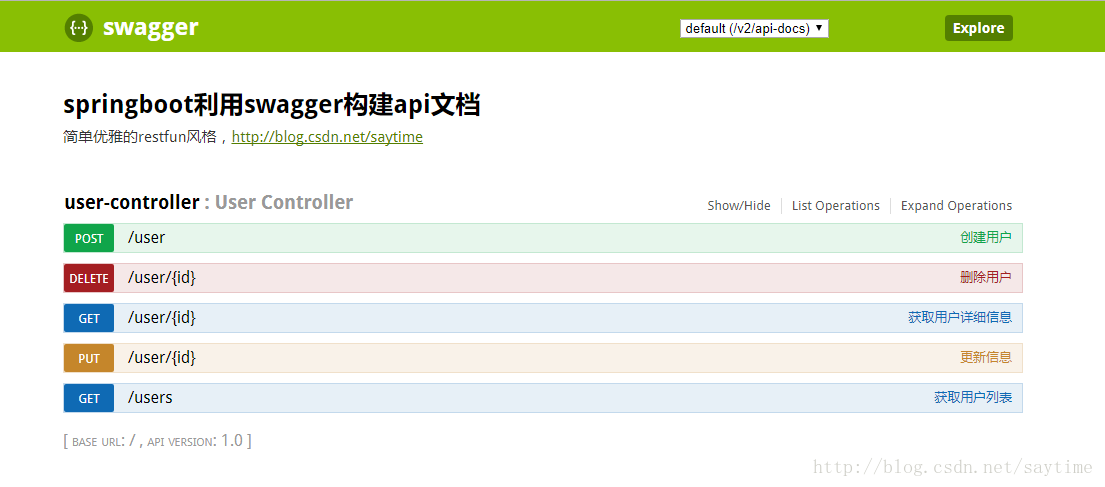一、在pom.xml引入相关jar
<!-- Swagger2 -->
<dependency>
<groupId>io.springfox</groupId>
<artifactId>springfox-swagger2</artifactId>
<version>2.6.1</version>
</dependency>
<dependency>
<groupId>io.springfox</groupId>
<artifactId>springfox-swagger-ui</artifactId>
<version>2.6.1</version>
</dependency>二、Swagger配置类
import org.springframework.context.annotation.Bean;
import org.springframework.context.annotation.Configuration;
import springfox.documentation.builders.ApiInfoBuilder;
import springfox.documentation.builders.PathSelectors;
import springfox.documentation.builders.RequestHandlerSelectors;
import springfox.documentation.service.ApiInfo;
import springfox.documentation.spi.DocumentationType;
import springfox.documentation.spring.web.plugins.Docket;
/**
* @author zh
* @ClassName cn.saytime.Swgger2
* @Description
* @date 2017-07-10 22:12:31
*/
@Configuration
public class Swagger2 {
@Bean
public Docket createRestApi() {
return new Docket(DocumentationType.SWAGGER_2)
.apiInfo(apiInfo())
.select()
.apis(RequestHandlerSelectors.basePackage("cn.saytime.web"))
.paths(PathSelectors.any())
.build();
}
private ApiInfo apiInfo() {
return new ApiInfoBuilder()
.title("springboot利用swagger构建api文档")
.description("简单优雅的restfun风格,http://blog.csdn.net/saytime")
.termsOfServiceUrl("http://blog.csdn.net/saytime")
.version("1.0")
.build();
}
}
用@Configuration注解该类,等价于XML中配置beans;用@Bean标注方法等价于XML中配置bean。
Application.class 加上注解@EnableSwagger2 表示开启Swagger
import org.springframework.boot.SpringApplication; import org.springframework.boot.autoconfigure.SpringBootApplication; import springfox.documentation.swagger2.annotations.EnableSwagger2; @SpringBootApplication @EnableSwagger2 public class SpringbootSwagger2Application { public static void main(String[] args) { SpringApplication.run(SpringbootSwagger2Application.class, args); } }
三、控制层的配置
package com.raorao;
import java.io.IOException;
import javax.servlet.http.HttpServletRequest;
import javax.servlet.http.HttpServletResponse;
import org.springframework.stereotype.Controller;
import org.springframework.web.bind.annotation.PathVariable;
import org.springframework.web.bind.annotation.RequestMapping;
import org.springframework.web.bind.annotation.RequestParam;
import org.springframework.web.bind.annotation.ResponseBody;
import org.springframework.web.servlet.ModelAndView;
import com.raorao.model.person;
import io.swagger.annotations.Api;
import io.swagger.annotations.ApiOperation;
import io.swagger.annotations.ApiResponse;
//其他通用demo
@Api(value = "Api控制器")
@Controller
@RequestMapping("/index")
public class IndexController {
String message="欢迎进入springmvc程序";
@RequestMapping("/showMessage")
public ModelAndView showMessage(@RequestParam(value="name",required=false,defaultValue="spring") String name)
{
ModelAndView mv=new ModelAndView("index");//指定试图
//向视图中添加所要展示或使用的内容,将在页面中使用
mv.addObject("message", message);
mv.addObject("name", name);
return mv;
}
@ResponseBody
@RequestMapping("/hello")
public String hello(HttpServletRequest request,HttpServletResponse response)throws IOException{
//response.setContentType("application/json;charset=UTF-8");
System.out.println("执行了");
//response.getWriter().append("这里是hello");
return "这里是hello";
}
//rest服务
@ResponseBody
@RequestMapping("/rest/{id}")
public String rest(@PathVariable("id") Integer id){
//response.setContentType("application/json;charset=UTF-8");
System.out.println("执行了");
//response.getWriter().append("这里是hello");
return "id="+id.toString();
}
//rest服务返回json格式数据
@ResponseBody
@RequestMapping("/json")
@ApiResponse(code = 200, message = "success", response = person.class)
@ApiOperation(value = "返回json数据", response = String.class, notes = "返回json数据")
public person json(){
//response.setContentType("application/json;charset=UTF-8");
System.out.println("执行了json");
//response.getWriter().append("这里是hello");
person p=new person();
p.setName("王小二");
p.setAge(123);
return p;
}
}
在浏览器中输入http://localhost:8080/swagger-ui.html,将会出现如下界面:

四、Swagger注解
swagger通过注解表明该接口会生成文档,包括接口名、请求方法、参数、返回信息的等等。
@Api:修饰整个类,描述Controller的作用
@ApiOperation:描述一个类的一个方法,或者说一个接口
@ApiParam:单个参数描述
@ApiModel:用对象来接收参数
@ApiProperty:用对象接收参数时,描述对象的一个字段
@ApiResponse:HTTP响应其中1个描述
@ApiResponses:HTTP响应整体描述
@ApiIgnore:使用该注解忽略这个API
@ApiError :发生错误返回的信息
@ApiImplicitParam:一个请求参数
@ApiImplicitParams:多个请求参数